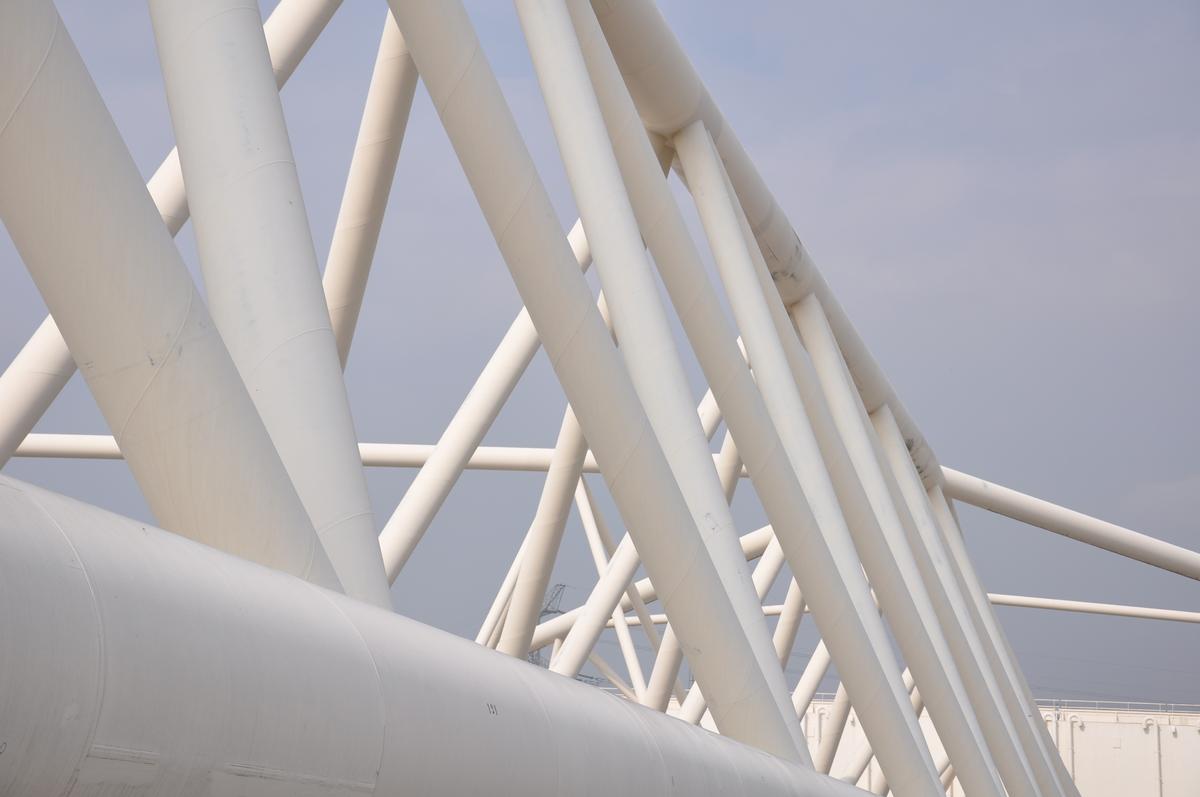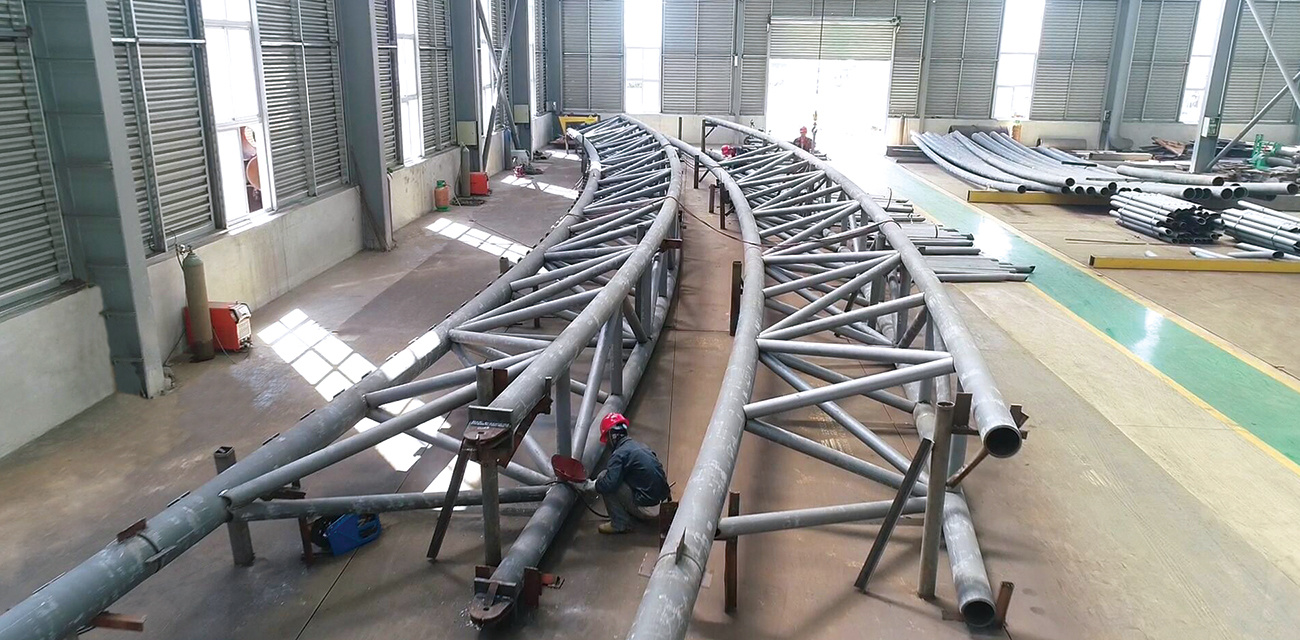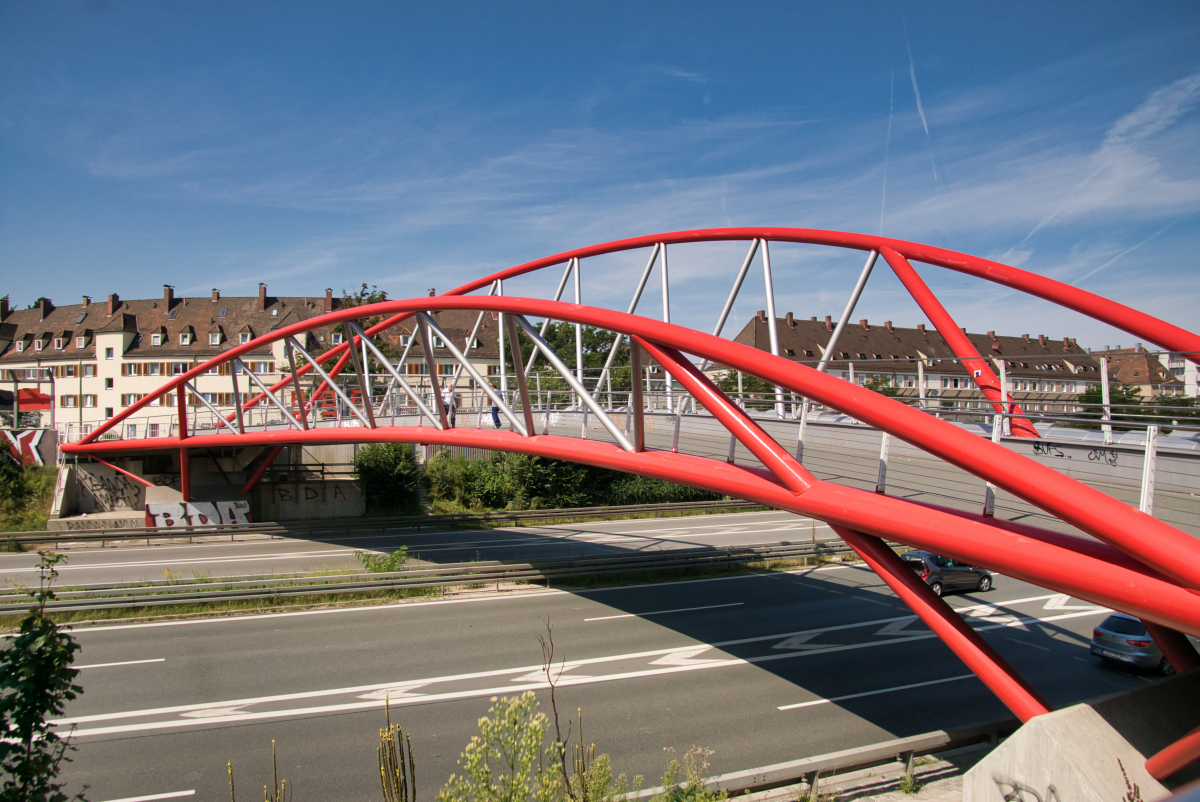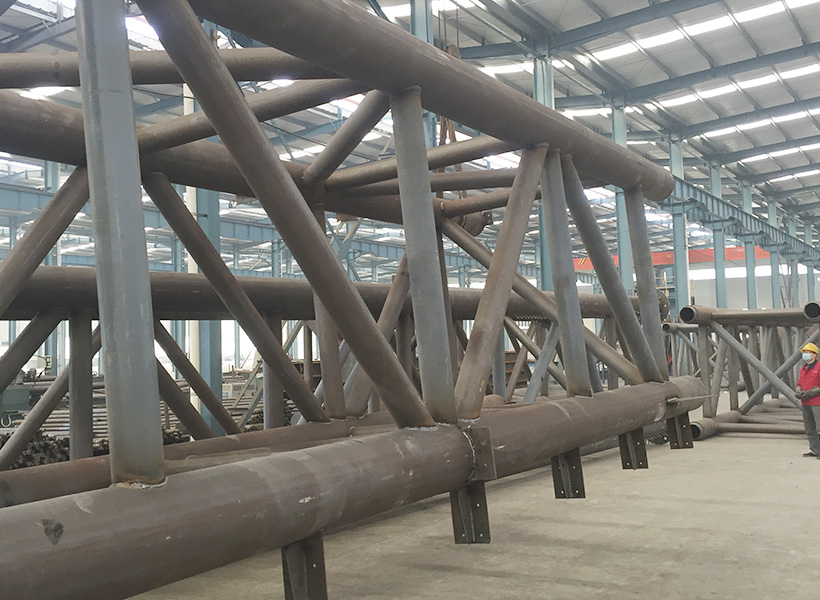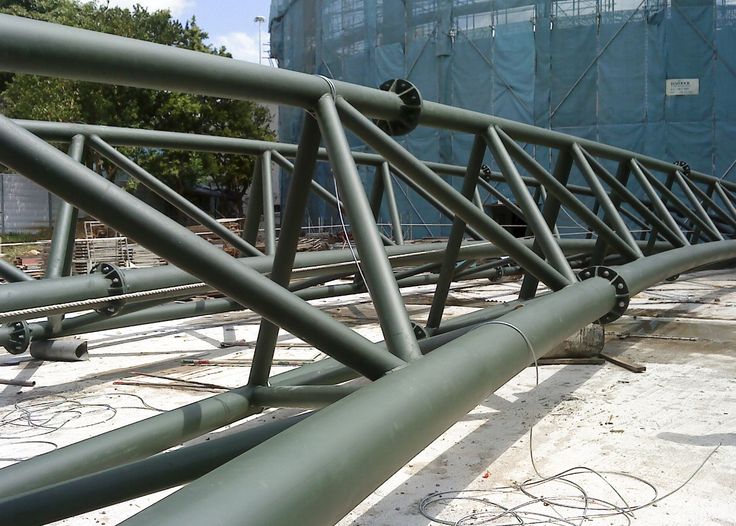Comprehensive Guide to Steel Pipe Trusses
Introduction
In modern construction, steel pipe trusses have become a popular choice for supporting large-span structures due to their strength, versatility, and aesthetic appeal. These trusses are widely used in various industries, including industrial buildings, warehouses, stadiums, and bridges, where the ability to span large distances without internal supports is crucial.
This guide will provide an in-depth look at steel pipe trusses, covering their characteristics, applications, classifications, and composition. We will also explore the advantages and disadvantages of using pipe trusses in construction, helping you make informed decisions when selecting the right structural solution for your project.
What is a Steel Pipe Truss?
A steel pipe truss is a structural framework composed of interconnected steel pipes arranged in a triangular or polygonal pattern. These trusses are designed to support loads over large spans, distributing the weight evenly across the structure. The use of circular steel pipes in trusses provides several benefits, including improved strength, reduced weight, and enhanced aesthetic appeal.
Pipe trusses are commonly used in applications where large, open spaces are required, such as stadiums, airports, industrial facilities, and bridges. The geometric arrangement of the pipes allows the truss to support heavy loads while minimizing the amount of material required, making it a cost-effective solution for large-span structures.
Key Features of Steel Pipe Trusses
- High Strength-to-Weight Ratio: Steel pipe trusses are designed to provide maximum strength while using minimal material, resulting in a lightweight yet strong structure.
- Aesthetic Appeal: The circular shape of the pipes gives the truss a sleek, modern appearance, making it an attractive option for architectural applications.
- Versatility: Steel pipe trusses can be customized to fit a wide range of designs and applications, making them suitable for both industrial and commercial projects.
- Durability: Steel is highly resistant to corrosion and wear, ensuring that pipe trusses have a long service life even in harsh environments.
Characteristics of Steel Pipe Trusses
Steel pipe trusses possess several characteristics that make them an ideal choice for large-span structures. These characteristics include:
1. Geometric Efficiency
The triangular or polygonal arrangement of the pipes in a truss allows the structure to distribute loads efficiently, reducing the amount of material required. This geometric efficiency makes pipe trusses lightweight yet strong, allowing them to span large distances without the need for internal supports.
2. High Load-Bearing Capacity
Steel pipe trusses are designed to support heavy loads, making them suitable for applications where large spans and high loads are required. The circular shape of the pipes provides additional strength, allowing the truss to resist bending and buckling under heavy loads.
3. Flexibility in Design
Steel pipe trusses can be customized to fit a wide range of architectural designs and functional requirements. The pipes can be arranged in various geometric patterns, including triangular, trapezoidal, and polygonal configurations, allowing for flexibility in design.
4. Corrosion Resistance
Steel pipe trusses are often coated with protective materials, such as galvanization or paint, to prevent corrosion. This makes them suitable for use in outdoor environments or in structures exposed to moisture and chemicals.
5. Ease of Fabrication and Installation
Steel pipe trusses can be prefabricated off-site and then assembled on-site, reducing construction time and labor costs. The use of steel pipes also allows for easy welding and bolting, making the installation process straightforward.
Applications of Steel Pipe Trusses
Steel pipe trusses are used in a wide range of industries and applications due to their strength, durability, and versatility. Some of the most common applications include:
1. Industrial Buildings
In industrial buildings such as factories, warehouses, and manufacturing facilities, steel pipe trusses are used to support large roofs and provide open, unobstructed spaces for machinery and equipment.
- Applications:
- Factory roofs
- Warehouse structures
- Manufacturing plants
2. Stadiums and Arenas
Stadiums and arenas require large, open spaces to accommodate thousands of spectators. Steel pipe trusses are ideal for these applications because they can span large distances without the need for internal columns, providing unobstructed views for spectators.
- Applications:
- Sports stadiums
- Concert arenas
- Convention centers
3. Bridges
Steel pipe trusses are commonly used in the construction of bridges, where their high strength and ability to span large distances make them an ideal choice. The trusses can support both pedestrian and vehicular traffic while maintaining a lightweight design.
- Applications:
- Pedestrian bridges
- Vehicular bridges
- Railway bridges
4. Airports and Transportation Hubs
Airports and transportation hubs often require large-span roof structures to cover terminals, hangars, and other facilities. Steel pipe trusses provide the strength and flexibility needed to cover these large areas while maintaining a modern, aesthetically pleasing design.
- Applications:
- Airport terminals
- Train stations
- Bus depots
5. Exhibition Halls and Convention Centers
Exhibition halls and convention centers often require large-span roof structures to accommodate large crowds and exhibition booths. Steel pipe trusses provide the strength and flexibility needed to cover these large areas while maintaining an open, airy feel.
- Applications:
- Exhibition halls
- Convention centers
- Trade show venues
Classification of Steel Pipe Trusses
Steel pipe trusses can be classified into several types based on their geometric configuration and the way they are connected. Below are some of the most common classifications of steel pipe trusses:
1. Fixed Pipe Truss
A fixed pipe truss is a type of truss where the ends of the truss are fixed to the supports, preventing any movement or rotation. This type of truss is commonly used in applications where stability and rigidity are required.
- Characteristics:
- Fixed connections at the supports
- High stability and rigidity
- Suitable for large-span structures
2. Folding Pipe Truss
A folding pipe truss is designed to be collapsible, allowing it to be folded for easy transportation and storage. This type of truss is commonly used in temporary structures, such as event stages and exhibition booths.
- Characteristics:
- Collapsible design for easy transportation
- Suitable for temporary structures
- Lightweight and easy to assemble
3. Butterfly Pipe Truss
A butterfly pipe truss is a type of truss with a unique geometric design that resembles the wings of a butterfly. This type of truss is often used in architectural applications where aesthetic appeal is important.
- Characteristics:
- Aesthetic, butterfly-shaped design
- Suitable for architectural applications
- Provides both strength and visual appeal
4. Ball Joint Pipe Truss
A ball joint pipe truss uses ball joints to connect the individual pipes, allowing for greater flexibility in the design and assembly of the truss. This type of truss is commonly used in complex structures where multiple angles and connections are required.
- Characteristics:
- Ball joints for flexible connections
- Suitable for complex structures
- Allows for multiple angles and connections
5. Triangular Pipe Truss
A triangular pipe truss is a type of truss where the pipes are arranged in a triangular pattern. This is one of the most common types of trusses, as the triangular configuration provides excellent strength and stability.
- Characteristics:
- Triangular arrangement of pipes
- High strength and stability
- Suitable for large-span structures
6. Trapezoidal Pipe Truss
A trapezoidal pipe truss is a type of truss where the pipes are arranged in a trapezoidal pattern. This type of truss is often used in applications where a wider base is required for stability.
- Characteristics:
- Trapezoidal arrangement of pipes
- Wider base for additional stability
- Suitable for large-span structures
7. Polygonal Pipe Truss
A polygonal pipe truss is a type of truss where the pipes are arranged in a polygonal pattern, such as a hexagon or octagon. This type of truss is often used in architectural applications where a unique geometric design is desired.
- Characteristics:
- Polygonal arrangement of pipes
- Suitable for architectural applications
- Provides both strength and visual appeal
8. Open-Web Pipe Truss
An open-web pipe truss is a type of truss where the pipes are arranged in an open-web pattern, allowing for greater airflow and light penetration. This type of truss is commonly used in roof structures and ceilings.
- Characteristics:
- Open-web design for airflow and light penetration
- Suitable for roof structures and ceilings
- Lightweight and easy to install
Table 1: Classification of Steel Pipe Trusses
| Type of Pipe Truss | Key Characteristics | Applications |
|---|---|---|
| Fixed Pipe Truss | Fixed connections, high stability | Large-span structures |
| Folding Pipe Truss | Collapsible, easy to transport | Temporary structures |
| Butterfly Pipe Truss | Aesthetic design, butterfly-shaped | Architectural applications |
| Ball Joint Pipe Truss | Flexible connections, ball joints | Complex structures |
| Triangular Pipe Truss | Triangular arrangement, high strength | Large-span structures |
| Trapezoidal Pipe Truss | Trapezoidal arrangement, wider base | Large-span structures |
| Polygonal Pipe Truss | Polygonal arrangement, unique geometric design | Architectural applications |
| Open-Web Pipe Truss | Open-web design, lightweight | Roof structures, ceilings |
Composition of Steel Pipe Trusses
The composition of steel pipe trusses involves several key components, each of which plays a crucial role in the overall strength and stability of the structure. Below are the main components of a steel pipe truss:
1. Top Chord
The top chord is the uppermost horizontal member of the truss, which is responsible for supporting the roof or other loads placed on the structure. The top chord is typically made from high-strength steel pipes to ensure that it can support heavy loads.
2. Bottom Chord
The bottom chord is the lowermost horizontal member of the truss, which helps to resist tension forces and maintain the overall stability of the structure. Like the top chord, the bottom chord is made from high-strength steel pipes.
3. Web Members
The web members are the diagonal and vertical members that connect the top and bottom chords. These members help to distribute loads evenly across the truss and provide additional stability.
4. Connections
The connections between the individual pipes in a truss are typically made using welds, bolts, or ball joints. These connections are critical to the overall strength and stability of the truss, as they ensure that the individual members work together as a single unit.
5. Bracing
Bracing is used to provide additional stability to the truss, particularly in areas where the structure is subjected to lateral loads, such as wind or seismic forces. Bracing can be added in the form of diagonal members or cross-bracing.
Advantages and Disadvantages of Steel Pipe Trusses
Advantages of Steel Pipe Trusses
Steel pipe trusses offer several advantages over other types of structural systems, making them a popular choice for large-span structures. Some of the key advantages include:
1. High Strength-to-Weight Ratio
Steel pipe trusses are designed to provide maximum strength while using minimal material, resulting in a lightweight yet strong structure. This makes them ideal for applications where large spans and heavy loads are required.
2. Aesthetic Appeal
The circular shape of the pipes gives the truss a sleek, modern appearance, making it an attractive option for architectural applications. Steel pipe trusses can also be customized to fit a wide range of designs, allowing for flexibility in aesthetic design.
3. Cost-Effective
While steel pipe trusses may have a higher initial cost compared to other materials, their long service life and reduced maintenance requirements make them a cost-effective choice in the long run. The lightweight design of the trusses also reduces the need for heavy foundations, further lowering construction costs.
4. Durability
Steel is highly resistant to corrosion, wear, and environmental damage, ensuring that pipe trusses have a long service life even in harsh environments. This durability reduces the need for frequent repairs or replacements, resulting in lower maintenance costs over time.
5. Versatility
Steel pipe trusses can be customized to fit a wide range of designs and applications, making them suitable for both industrial and commercial projects. The pipes can be arranged in various geometric patterns, allowing for flexibility in design.
Disadvantages of Steel Pipe Trusses
While steel pipe trusses offer several advantages, there are also some disadvantages to consider:
1. Higher Initial Cost
Steel pipe trusses can have a higher initial cost compared to other materials, such as wood or concrete. This is due to the cost of the steel itself, as well as the fabrication and installation process.
2. Corrosion Risk
Although steel is highly resistant to corrosion, it can still be susceptible to rust if not properly protected. This is particularly true in outdoor environments or in structures exposed to moisture and chemicals. Protective coatings, such as galvanization or paint, are often required to prevent corrosion.
3. Complex Fabrication and Installation
The fabrication and installation of steel pipe trusses can be more complex compared to other types of structures. This is due to the need for precise welding and bolting, as well as the geometric arrangement of the pipes. As a result, the construction process may take longer and require specialized labor.
Table 2: Advantages and Disadvantages of Steel Pipe Trusses
| Advantages | Disadvantages |
|---|---|
| High strength-to-weight ratio | Higher initial cost |
| Aesthetic appeal | Corrosion risk if not properly protected |
| Cost-effective in the long run | Complex fabrication and installation |
| Durable and resistant to environmental damage | |
| Versatile and customizable |
Conclusion
Steel pipe trusses are a versatile and durable solution for large-span structures, offering a combination of strength, aesthetic appeal, and cost-effectiveness. Whether used in stadiums, airports, industrial buildings, or bridges, these trusses provide the performance and reliability needed to support heavy loads over long spans.
By understanding the characteristics, applications, and classifications of steel pipe trusses, as well as the advantages and disadvantages of using them, you can make informed decisions when selecting the right structural system for your project. Additionally, the flexibility in design and customization options available with steel pipe trusses allows for a wide range of architectural possibilities, making them a popular choice in modern construction.
FAQ
What is a steel pipe truss?
A steel pipe truss is a structural framework composed of interconnected steel pipes arranged in a triangular or polygonal pattern. These trusses are used to support large-span structures, distributing loads evenly across the structure.
What are the advantages of steel pipe trusses?
The key advantages of steel pipe trusses include their high strength-to-weight ratio, aesthetic appeal, cost-effectiveness, durability, and versatility. These trusses are ideal for large-span structures where strength and flexibility are required.
What are the common applications of steel pipe trusses?
Steel pipe trusses are commonly used in industrial buildings, stadiums, bridges, airports, and exhibition halls. They are ideal for applications that require large, open spaces without internal supports.
How are steel pipe trusses classified?
Steel pipe trusses can be classified into several types, including fixed pipe trusses, folding pipe trusses, butterfly pipe trusses, ball joint pipe trusses, triangular pipe trusses, trapezoidal pipe trusses, polygonal pipe trusses, and open-web pipe trusses.
What are the disadvantages of steel pipe trusses?
The main disadvantages of steel pipe trusses include their higher initial cost, risk of corrosion, and complex fabrication and installation process. However, these disadvantages can be mitigated with proper maintenance and protective coatings.

